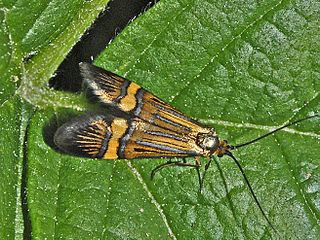
The longhorn moth or yellow-barred long-horn is a diurnal lepidopteran from the moths family Adelidae.

Cydia fagiglandana, the beech moth, is a moth of the family Tortricidae.
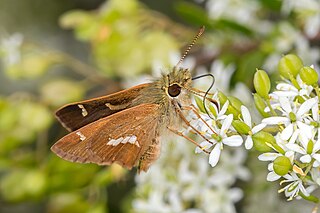
Dispar compacta, commonly known as the dispar skipper, barred skipper, or barred grass-skipper, is a species of butterfly in the family Hesperiidae. It was described by Arthur Gardiner Butler in 1882 as Telesto compacta and is endemic to eastern Australia.
Hyposmocoma trivitella is a species of moth of the family Cosmopterigidae. It was first described by Otto Swezey in 1913. It is endemic to the Hawaiian island of Kauai. The type locality is Haleakalā.
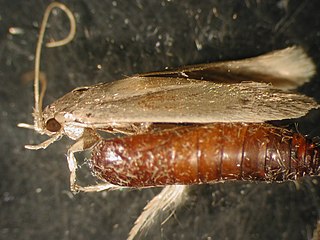
Opogona sacchari, the banana moth, is a moth of the family Tineidae. The species was first described by Wenceslas Bojer in 1856. It is native to the humid tropical and subtropical regions of sub-Saharan Africa, where it is also found in Madagascar, Mauritius, Réunion, Rodrigues Island, the Seychelles and St. Helena. It was first reported from the Canary Islands in the 1920s. In the 1970s, it was introduced into Brazil and Central America, and also appeared in Europe. It has been reported from Florida since 1986.

Hellula undalis, the cabbage webworm or Old World webworm, is a moth of the family Crambidae. It is a widespread species which is found from Europe across Asia to the Pacific. It was first described from Italy.

Epirrhoe galiata, the galium carpet, is a moth of the family Geometridae.

Isonomeutis amauropa is a species of moth in the Copromorphidae family. It is endemic to New Zealand where it can be found on both the North and South Islands. I. amauropa inhabits native forest particularly forest dominated by Rimu and native beech trees. The larvae of this species consumes margarodid scale insects that live under the bark of these trees. When mature the larvae pupate in a cocoon made of silk and covered in twigs and frass. This cocoon is normally placed under the bark of the same tree the larvae inhabited. Adults of I. amauropa are on the wing from September to February.

Pebobs ipomoeae is a moth of the family Cosmopterigidae. It is known from Florida.

Synanthedon formicaeformis, the red-tipped clearwing, is a moth of the family Sesiidae and can be found in all of Europe, the eastern Palearctic realm, and the Near East. The larvae sometimes form pear-shaped galls on willows. It was first described by Eugenius Johann Christoph Esper in 1783.
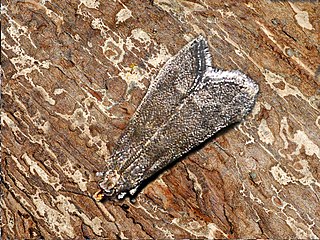
Eccopisa is a genus of snout moths. It was described by Philipp Christoph Zeller in 1848.

Gesonia obeditalis is a species of moth of the family Noctuidae first described by Francis Walker in 1859. It is found from eastern Africa, the Seychelles, the Maldives and the Oriental tropics of India, Myanmar, Sri Lanka east to the Philippines, the Sula Islands and Australia. The adult moth has brown wings with a scalloped dark brown band near the margin. The hindwings are similar in pattern to the forewings but are a paler shade of brown.

Orenaia alpestralis is a species of moth in the family Crambidae.
Palaeomystella tibouchinae is a moth of the family Agonoxenidae. It is found in Brazil.
Palaeomystella oligophaga is a moth of the family Agonoxenidae. It is found in Brazil.

Eucosma aspidiscana, the golden-rod bell, is a species of moth of the family Tortricidae. It is found in China, Mongolia, Korea, Japan, Russia, North Africa and most of Europe. The habitat consists of woodlands, downland, waste grounds and cliffs.
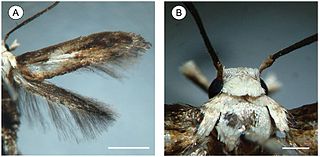
Palaeomystella fernandesi is a moth of the family Agonoxenidae. It is found in Atlantic rain forest of Brazil.
Palaeomystella tavaresi is a moth of the family Agonoxenidae. It is found in the Atlantic Forest at the Serra Bonita Reserve in Brazil.

Filatima pseudacaciella, the dusky-backed filatima moth, is a moth of the family Gelechiidae. It is found in North America, where it has been recorded from California, Illinois, Indiana, Kansas, Kentucky, Louisiana, Maine, Massachusetts, Mississippi, New Hampshire, New York, Ohio, Oklahoma, Ontario, Tennessee and West Virginia.

Austramathes purpurea is a species of moth in the family Noctuidae. It is endemic to New Zealand and can be found throughout the North and South Islands but has yet to be recorded at Stewart Island. It inhabits native forest. This species might possibly be confused with A. pessota, however this latter species does not have the purple hue to the forewings. The larvae of A. purpurea feed primarily on māhoe but have been recorded as feeding on, and have been reared on, narrow-leaved māhoe. The larvae pupate in a silken cocoon on moss covered ground. Adults can be found on the wing during the months of March to January but mainly occur during New Zealand's late autumn, winter, and spring. Light trapping may not be the most efficient technique for collecting this species.
















